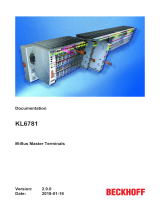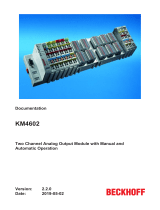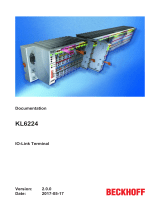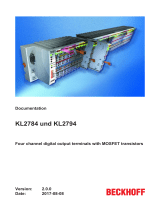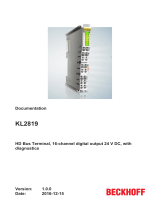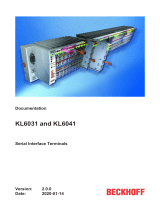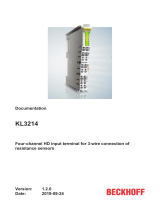Page is loading ...

Documentation
KL31x2
Two Channel Accurate Analog Terminals
2.4.0
2019-02-11
Version:
Date:


Table of contents
KL31x2 3Version: 2.4.0
Table of contents
1 Foreword ....................................................................................................................................................5
1.1 Notes on the documentation..............................................................................................................5
1.2 Safety instructions .............................................................................................................................6
1.3 Documentation issue status ..............................................................................................................7
2 Product overview.......................................................................................................................................9
2.1 KL3132, KL3162, KL3172, KL3182 ...................................................................................................9
2.1.1 Introduction ........................................................................................................................ 9
2.1.2 Technical data ................................................................................................................. 10
2.2 KL3142, KL3152 .............................................................................................................................11
2.2.1 Introduction ...................................................................................................................... 11
2.2.2 Technical data ................................................................................................................. 12
2.3 Basic function principles ..................................................................................................................13
2.4 LEDs................................................................................................................................................17
3 Fitting and wiring.....................................................................................................................................18
3.1 Installation on mounting rails ...........................................................................................................18
3.2 Connection ......................................................................................................................................20
3.2.1 Connection system .......................................................................................................... 20
3.2.2 Wiring............................................................................................................................... 22
3.2.3 Shielding .......................................................................................................................... 23
3.2.4 Pin assignment ................................................................................................................ 24
3.3 ATEX - Special conditions (standard temperature range) ...............................................................26
3.4 ATEX Documentation ......................................................................................................................27
3.5 Application example for KL3172-0000.............................................................................................28
4 Configuration Software KS2000.............................................................................................................29
4.1 KS2000 - Introduction......................................................................................................................29
4.2 Parameterization with KS2000 ........................................................................................................31
4.3 Register ...........................................................................................................................................33
4.4 Settings............................................................................................................................................34
4.5 Sample program for KL register communication via EtherCAT on KL3314 exemplary...................36
5 Access from the user program ..............................................................................................................39
5.1 Process image.................................................................................................................................39
5.2 Mapping...........................................................................................................................................40
5.3 Control and status byte....................................................................................................................42
5.4 Register overview ............................................................................................................................45
5.5 Register description.........................................................................................................................46
5.6 Examples of Register Communication ............................................................................................52
5.6.1 Example 1: reading the firmware version from Register 9............................................... 52
5.6.2 Example 2: Writing to an user register............................................................................. 52
6 Appendix ..................................................................................................................................................55
6.1 Support and Service ........................................................................................................................55

Table of contents
KL31x24 Version: 2.4.0

Foreword
KL31x2 5Version: 2.4.0
1 Foreword
1.1 Notes on the documentation
Intended audience
This description is only intended for the use of trained specialists in control and automation engineering who
are familiar with the applicable national standards.
It is essential that the documentation and the following notes and explanations are followed when installing
and commissioning these components.
It is the duty of the technical personnel to use the documentation published at the respective time of each
installation and commissioning.
The responsible staff must ensure that the application or use of the products described satisfy all the
requirements for safety, including all the relevant laws, regulations, guidelines and standards.
Disclaimer
The documentation has been prepared with care. The products described are, however, constantly under
development.
We reserve the right to revise and change the documentation at any time and without prior announcement.
No claims for the modification of products that have already been supplied may be made on the basis of the
data, diagrams and descriptions in this documentation.
Trademarks
Beckhoff
®
, TwinCAT
®
, EtherCAT
®
, EtherCATP
®
, SafetyoverEtherCAT
®
, TwinSAFE
®
, XFC
®
and XTS
®
are
registered trademarks of and licensed by Beckhoff Automation GmbH.
Other designations used in this publication may be trademarks whose use by third parties for their own
purposes could violate the rights of the owners.
Patent Pending
The EtherCAT Technology is covered, including but not limited to the following patent applications and
patents: EP1590927, EP1789857, DE102004044764, DE102007017835 with corresponding applications or
registrations in various other countries.
The TwinCAT Technology is covered, including but not limited to the following patent applications and
patents: EP0851348, US6167425 with corresponding applications or registrations in various other countries.
EtherCAT
®
is registered trademark and patented technology, licensed by Beckhoff Automation GmbH,
Germany.
Copyright
© Beckhoff Automation GmbH & Co. KG, Germany.
The reproduction, distribution and utilization of this document as well as the communication of its contents to
others without express authorization are prohibited.
Offenders will be held liable for the payment of damages. All rights reserved in the event of the grant of a
patent, utility model or design.

Foreword
KL31x26 Version: 2.4.0
1.2 Safety instructions
Safety regulations
Please note the following safety instructions and explanations!
Product-specific safety instructions can be found on following pages or in the areas mounting, wiring,
commissioning etc.
Exclusion of liability
All the components are supplied in particular hardware and software configurations appropriate for the
application. Modifications to hardware or software configurations other than those described in the
documentation are not permitted, and nullify the liability of Beckhoff Automation GmbH & Co. KG.
Personnel qualification
This description is only intended for trained specialists in control, automation and drive engineering who are
familiar with the applicable national standards.
Description of instructions
In this documentation the following instructions are used.
These instructions must be read carefully and followed without fail!
DANGER
Serious risk of injury!
Failure to follow this safety instruction directly endangers the life and health of persons.
WARNING
Risk of injury!
Failure to follow this safety instruction endangers the life and health of persons.
CAUTION
Personal injuries!
Failure to follow this safety instruction can lead to injuries to persons.
NOTE
Damage to environment/equipment or data loss
Failure to follow this instruction can lead to environmental damage, equipment damage or data loss.
Tip or pointer
This symbol indicates information that contributes to better understanding.

Foreword
KL31x2 7Version: 2.4.0
1.3 Documentation issue status
Version Comment
2.4.0 • Note on differential measurement added
2.3.0 • Example program added to chapter “KS2000 Configuration software“
2.2.0 • Update section “Technical data” (voltage measurement terminals only)
2.1.0 • Update section “Basic function principles”
2.0.0 • Migration
1.6.0 • Title page and introduction corrected
• Preface updated
• Technical data updated
1.5.0 • Register description updated (R32)
• Technical data updated
• KL3172-0500 and KL3172-1000 added
• ATEX notes added
1.4 • Control and status byte updated
• Mounting description expanded
1.3 • LED descriptions updated (prisms, new RUN LEDs)
• Connection description updated (power contacts, new pin assignment for terminal points)
• Channel switch-off added
• Technical data of the KL3142 and KL3152 updated
1.2.1 • Pin assignment corrected
1.2 • Register description extended (command 7000)
1.1 • Technical data updated
• Description of terminal points 3 and 7 adapted to final pin assignment
• KL3132, KL3142, KL3152, KL3162 and KL3182 added
1.0 First version (KL3172 only)
Firmware and hardware versions
Documen-
tation,
Version
KL3132-0000 KL3142-0000 KL3152-0000 KL3162-0000 KL3172-0000 KL3172-0500,
KL3172-1000
KL3182-0000
Firmw Hardw Firmw Hardw Firmw Hardw Firmw Hardw Firmw Hardw Firmw Hardw Firmw Hardw
2.4.0 2D 04 2E 04 2D 04 2D 04 2D 03 2D 03 2D 03
2.3.0 2D 04 2E 04 2D 04 2D 04 2D 03 2D 02 2D 03
2.2.0 2D 04 2E 04 2D 04 2D 04 2D 03 2D 02 2D 03
2.1.0 2D 04 2E 04 2D 04 2D 04 2D 03 2D 02 2D 03
2.0.0 2D 04 2E 04 2D 04 2D 04 2D 03 2D 02 2D 03
1.6.0 2D 03 2E 03 2D 03 2D 03 2D 02 2D 02 2D 02
1.5.0 2D 03 2E 03 2D 03 2D 03 2D 02 2D 02 2D 02
1.4 2A 01 2B 01 2A 01 2A 01 2A 01 - - 2A 01
1.3 2A 01 2A 01 2A 01 2A 01 2A 01 2A 01
1.2.1 1A 00 1A 00 1A 00 1A 00 1B 00 1A 00
1.2 1A 00 1A 00 1A 00 1A 00 1B 00 1A 00
1.1 1A 00 1A 00 1A 00 1A 00 1B 00 1A 00
1.0 - - - - - - - - B1 00 - -
The firmware and hardware versions (delivery state) can be taken from the serial number printed on the side
of the terminal.
Syntax of the serial number
Structure of the serial number: WWYYFFHH

Foreword
KL31x28 Version: 2.4.0
WW - week of production (calendar week)
YY - year of production
FF - firmware version
HH - hardware version
Example with ser. no.: 35 04 1B 01:
35 - week of production 35
4 - year of production 2004
1B - firmware version 1B
1 - hardware version 1

Product overview
KL31x2 9Version: 2.4.0
2 Product overview
2.1 KL3132, KL3162, KL3172, KL3182
2.1.1 Introduction
Fig.1: KL3132
Two-channel analog terminals with voltage inputs (0.05% accuracy)
The analog input terminals KL3132, KL3162, KL3172 and KL3182 process signals in the range -10V to
+10V. The voltage is digitized to a resolution of 16bits, and is transmitted, electrically isolated, to the higher-
level automation device. The input channels of one Bus Terminal have differential inputs and possess a
common, internal ground potential. With their small measuring error of ±0.05% of the full scale value, these
terminals are optimized for high-precision control processes, suchas dosing, filling, or quality assurance.
The Bus Terminals combine 2 channels in a single housing. Status and error LEDs indicate the terminal
state.
Overview
KL3132-0000: -10... +10V
KL3162-0000:0... +10V
KL3172-0000:0.0... +2.0V
KL3172-0500:0.0... +0.5V
KL3172-1000:0.0... +1.0V
KL3182-0000: -2.0... +2.0V

Product overview
KL31x210 Version: 2.4.0
2.1.2 Technical data
Technical data KL3132-0000,
KS3132-0000
KL3162-0000,
KS3162-0000
KL3172-0000,
KS3172-0000
KL3172-0500,
KS3172-0500
KL3172-1000,
KS3172-1000
KL3182-0000,
KS3182-0000
Number of inputs 2
Input signal -10V ... +10V 0 ... 10V 0 ... 2V 0 ... 500mV 0 ... 1V -2V ... +2V
Input resistance >70kΩ
Common-mode voltage U
CM
±10V
Resolution 16bit
Conversion time 140ms, configurable
Measuring error (full measur-
ing range)
±0.05% of the full scale value, self-calibration
Bit width in the K-Bus I/O 2 x 16bit user data (optionally 2 x 8bit control/status)
Bit width in the input process
image
2 data words, 2 status byte
Bit width in the output process
image
2 data words, 2 control byte
Power supply for the electron-
ics
via the K-bus
Current consumption from K-
bus
typically 85mA
Electrical isolation 500V (differential input / K-bus)
Connection spring-loaded system
Pluggable wiring for all KSxxxx terminals
Weight approx. 70g
Dimensions (W x H x D) approx. 15mmx100mmx70mm (width aligned: 12mm)
Mounting [}18]
on 35mm mounting rail conforms to EN60715
Permissible ambient tempera-
ture range during operation
0°C ... + 55°C
Permissible ambient tempera-
ture range during storage
-25°C ... + 85°C
Permissible relative air hu-
midity
95%, no condensation
Vibration/shock resistance conforms to EN60068-2-6/ EN60068-2-27
EMC immunity/emission conforms to EN61000-6-2/ EN61000-6-4
Protection class IP20
Installation position variable
Approval CE, cULus, ATEX

Product overview
KL31x2 11Version: 2.4.0
2.2 KL3142, KL3152
2.2.1 Introduction
Fig.2: KL3142
Two-channel analog terminals with current inputs (0.05% accuracy)
The KL3142 and KL3152 analog input terminals handle signals in the range between 0 and 20mA, and
between 4 and 20mA respectively. The current is digitized to a resolution of 16bits (default: 15bits), and is
transmitted, in an electrically isolated form, to the higher-level automation device. The input channels of the
Bus Terminals have differential inputs and possess a common, internal ground potential. With their small
measuring error of ±0.05% of the full scale value, these terminals are optimized for high-precision control
processes, such as dosing, filling, or quality assurance. The Bus Terminals combine 2 channels in a single
housing. An open lead or overload condition are detected, and the terminal status is relayed to the controller
via the K-bus. Status and error LEDs indicate the terminal state.
Overview
KL3142-0000: 0... 20mA
KL3152-0000: 4 ... 20mA

Product overview
KL31x212 Version: 2.4.0
2.2.2 Technical data
Technical data KL3142-0000, KS3142-0000 KL3152-0000, KS3152-0000
Number of inputs 2
Signal current 0... 20mA 4... 20mA
Internal resistance 100Ω measuring resistance
Common-mode voltage U
CM
±10V
Resolution 16bit
Conversion time 140ms, configurable
Measuring error (full measuring range) ±0.05% of the full scale value, self-calibration
Bit width in the K-Bus I/O 2 x 16bit user data (optionally 2 x 8bit control/status)
Bit width in the input process image 2 data words, 2status byte
Bit width in the output process image 2 data words, 2control byte
Power supply for the electronics via the K-bus
Current consumption from K-bus typically 85mA
Surge voltage resistance 35V
DC
Electrical isolation 500V (differential input / K-bus)
Connection spring-loaded system
Pluggable wiring for all KSxxxx terminals
Weight approx. 70g
Dimensions (W x H x D) approx. 15mmx100mmx70mm (width aligned: 12mm)
Mounting [}18]
on 35mm mounting rail conforms to EN60715
Permissible ambient temperature range
during operation
0°C ... + 55°C
Permissible ambient temperature range
during storage
-25°C ... + 85°C
Permissible relative air humidity 95%, no condensation
Vibration/shock resistance conforms to EN60068-2-6/ EN60068-2-27
EMC immunity/emission conforms to EN61000-6-2/ EN61000-6-4
Protection class IP20
Installation position variable
Approval CE, cULus, ATEX

Product overview
KL31x2 13Version: 2.4.0
2.3 Basic function principles
The high-precision KL3172 analog input terminals can measuretwo voltages (KL3132, KL3162, KL3172,
KL3182) or two currents (KL3142, KL3152) and display them with a resolution of 16bits (65535 steps). High-
precision measurements are ensured through cyclic self-calibration.
By default, the inputs are switched as differential inputs. In the terminals KL3132, KL3162, KL3172 and
KL3182, the terminal point -E1 of the first channel can be connected to the internal analog ground with bit
R32.6 [}49] of the feature register.
Process data
Analog values are represented as follows:
Input signal Value
KL3142-0000 KL3152-0000 KL3162-0000 KL3172-0000 KL3172-0500 KL3172-1000 dec hex
0mA 4mA 0 V 0V 0V 0V 0 0x0000
20mA 20mA 10V 2 V 500mV 1V 65535 0xFFFF
Input signal Value
KL3132-0000 KL3182-0000 dec hex
-10V -2V -32768 0x8000
+10V +2 V +32767 0x7FFF
Calculation
The terminal continuously takes measured values and stores the raw values of its A/D converter in register
R0 [}46] (RAM ). After each recording of the analog signal, a correction is calculated using the
compensation and, if necessary, calibration values. This is followed by manufacturer and user scaling:
Y
A
=(X
ADC
+ B
A
) x A
A
(1.0) Manufacturer compensation (if calibration inactive)
Y
A
=((X
ADC
+ B
K
) x A
A
) x (A
GK
/
A
K
)
(1.1) Manufacturer compensation / calibration (if calibration activated)
Y
H
=Y
A
x A
H
+ B
H
(1.2) Manufacturer scaling
Y
aus
=Y
H
xA
W
+ B
W
(1.3) User scaling

Product overview
KL31x214 Version: 2.4.0
Key
Name Name Unit Register
X
ADC
Output value of the A/D converter [1] -
Y
out
Process data for controller [1] -
B
A
Vendor calibration: Offset (can be disabled via bit R32.5 [}49] of the
feature register)
[1]
R17 [}47]
A
A
Vendor calibration: Gain (always active) [1 x 2
-16
+ 1]
R18 [}47]
B
K
Calibration: Offset (can be enabled via bit R32.5 [}49] of the feature
register)
[1]
R1 [}46]
A
K
Calibration: Gain (can be enabled via bit R32.5 [}49] of the feature
register)
[1]
R2 [}46]
A
GK
Basic calibration: Gain (can be enabled via bit R32.5 [}49] of the
feature register)
[1]
R23 [}48]
B
H
Manufacturer scaling: Offset (can be enabled via bit R32.1 [}49] of the
feature register)
[1]
R19 [}48]
A
H
Manufacturer scaling: Gain (can be enabled via bit R32.1 [}49] of the
feature register)
[1 x 2
-8
+ 1]
R20 [}48]
B
W
User scaling: Offset (can be enabled via bit R32.0 [}49] of the feature
register)
[1]
R33 [}50]
A
W
User scaling: Gain (can be enabled via bit R32.0 [}49] of the feature
register)
[1 x 2
-8
+ 1]
R34 [}50]
Calibration
The analog channels are self‑calibrated periodically. Analog switches are provided for this purpose, so that
the various calibration signals can be connected. It is important for this process that the entire signal path,
including all passive components, is examined at every phase of the calibration. Only the interference
suppression elements (L/C combination) and the analog switches themselves cannot be examined.
The calibration interval is set in register R40 [}51] in steps of 100ms. During calibration, no current process
data are present. Value 0 is present. The terminal indicates active calibration by setting bit SB1.6 [}42] in
the status byte, and by switching off the associated RUN LED. Calibration can be disabled by the controller
via control byte CB1.1 [}42] if necessary. If calibration is disabled over a prolonged period, the terminal
carries out a forced calibration, in order to compensate any voltage drifts that may be caused by changes in
temperature. The forced calibration interval is specified via register R44 [}51]as a multiple of the calibration
interval. If a further calibration between two cycles is required, this can be started manually by setting bit
CB1.0 [}42]. The terminal then acts as if it had triggered a calibration itself.
Fluctuating measurement signals disturbing the self‑calibration
The terminal checks by a stabilization test while in calibration state whether the input signal is sta-
ble. Large variations of measurement signals prevent a completion of the self‑calibration; the termi-
nal remains in Error=1 and overload/underload=1, see sections "Basic function principles/ Calibra-
tion" [}14] and "Access from the user program/ Status byte 1 (for process data mode)" [}42].
If such a signal will be expected on a system plant, you can optionally:
‑lock the self‑calibration within the process via Control‑Bit CB1.1 [}42] as long a smooth signal is
present and the self‑calibration passes.
‑disabling the stabilization test process via bit R32.7 [}48].
‑disabling the indication of the stabilization error by bit R32.14 [}48].
‑increase the tolerance window of the stabilization control by register R48 [}51].
The functionality of the calibration including all features invariably refers to both channels simultaneously!
The channels cannot be calibrated individually. For this reason, the registers R40 [}51], R44 [}51], R47
[}51] and R48 [}51] are only implemented once for both channels.

Product overview
KL31x2 15Version: 2.4.0
• In the first phase of the calibration, an input voltage of 0V is applied to both analog inputs (zero
calibration). The zero points of both analog input stages can be determined in this way. For this
measurement, the respective absolute value of the channels is of interest. The value is subsequently
stored in the RAM (registerR1 [}46]).
• During the second calibration phase, an internal reference voltage of approx. 1.8V (final calibration) is
applied to both analog inputs. In this case, it is no longer the absolute value of the measurement result
that is of interest, but only any deviation from the basic calibration value determined during production
(registerR23 [}48]). The ratio between the two values is calculated and used in the next correction
calculation [}13]. The value is subsequently stored in the RAM (registerR2 [}46]).
Stabilization of the calibration
During the calibration, a stabilization of the offset and gain values is carried out. The calibration values are
only accepted once a certain number (specified via register R47 [}51]) of measured values is inside a
certain tolerance range (specified via register R48 [}51]). This further increases the precision. This function
can be deactivated via bit R32.7 [}49] .
Limit values
The terminal offers the option of monitoring two limit values per channel. Limit value 1 can be specified via
register R35 [}50], and limit value 2 via register R36 [}50]. They are activated via bits in the feature
registers R32.9 [}49]and R32.10 [}49]. The status of the current process data value is indicated to the
controller via the status byte SB1 [}42]. Possible states are: Process data equal limit value (3), process
data less than limit value (2), process data greater than limit value (1).
Limiting the measuring range
The terminal indicates any violation of the measuring range to the higher-level controller via the status byte.
• If the current measured value is larger than 0xFFFF or 0x7FFF, bit SB1.1 [}42] is set.
• Is the current measured value is less than 0 or 0x8000, bit SB1.0 [}42] is set.
In both cases, the ERROR LED of the respective channel will be on. This function can be deactivated via bit
R32.8 [}49].
Differential measurement
With the KL3132, KL3162, KL3172, KL3182, the differential measurement can be deactivated in R32.6.
Then, for channels 1 and 2, the input is internally switched to GND at terminal point 3/7, which must then be
wired externally accordingly.

Product overview
KL31x216 Version: 2.4.0
Fig.3: Differential measuring

Product overview
KL31x2 17Version: 2.4.0
2.4 LEDs
Fig.4: LEDs
LED Display
K-bus power
(green)
ON Power supply (5V) available on the K-bus
OFF No power supply (5V) available on the K-bus
K-Bus Run
(green)
ON Data transmission on the K-bus is active
OFF Data transmission on the K-bus is not active
Run 1
(green)
ON Channel1 active:
• process data contain valid analog value
OFF Channel1 not active:
• Calibration is performed, analog value in the process data not current (frozen or zero)
• or channel1 is switched off (if LED error1 not lit)
Error 1
(red)
ON
• Analog value of channel1 is above the valid measuring range, specified through register R21 [}48] of
channel1. Bit SB1.1 [}42] is set in the status byte of channel1.
• Analog value of channel1 is below the valid measuring range, specified through register R22 [}48] of
channel1. Bit SB1.0 [}42] is set in the status byte of channel1.
• Calibration is in progress. The LED goes out when the calibration is complete.
OFF • Analog value of channel1 is within the valid measuring range (if LED Run1 is lit)
• or channel1is switched off (if LED Run1 is not lit)
Run 2
(green)
ON Channel2 active:
• process data contain valid analog value
OFF Channel2 not active:
• Calibration is performed, analog value in the process data not current (frozen or zero)
• or channel2 is switched off (if LED error2 not lit)
Error 2
(red)
ON
• Analog value of channel2 is above the valid measuring range, specified through register R21 [}48] of
channel2. Bit SB2.1 [}44] is set in the status byte of channel2.
• Analog value of channel2 is below the valid measuring range, specified through register R22 [}48] of
channel2. Bit SB2.0 [}44] is set in the status byte of channel2.
• Calibration is in progress. The LED goes out when the calibration is complete.
OFF • Analog value of channel2 is within the valid measuring range (if LED Run2 is lit)
• or channel2is switched off (if LED Run2 is not lit)
Limiting the measuring range
The terminal indicates any violation of the measuring range to the higher-level controller via the status byte.
If the current measured value is:
• greater than specified in register R21 [}48], bit1 is set in the status byte,
• smaller than specified in register R22 [}48], bit0 is set in the status byte.
In both cases, the ERROR LED of the respective channel will be on. This display can be disabled through bit
R32.8 [}49].

Fitting and wiring
KL31x218 Version: 2.4.0
3 Fitting and wiring
3.1 Installation on mounting rails
WARNING
Risk of electric shock and damage of device!
Bring the bus terminal system into a safe, powered down state before starting installation, disassembly or
wiring of the bus terminals!
Assembly
Fig.5: Attaching on mounting rail
The bus coupler and bus terminals are attached to commercially available 35mm mounting rails (DIN rails
according to EN60715) by applying slight pressure:
1. First attach the fieldbus coupler to the mounting rail.
2. The bus terminals are now attached on the right-hand side of the fieldbus coupler. Join the compo-
nents with tongue and groove and push the terminals against the mounting rail, until the lock clicks
onto the mounting rail.
If the terminals are clipped onto the mounting rail first and then pushed together without tongue and
groove, the connection will not be operational! When correctly assembled, no significant gap should
be visible between the housings.
Fixing of mounting rails
The locking mechanism of the terminals and couplers extends to the profile of the mounting rail. At
the installation, the locking mechanism of the components must not come into conflict with the fixing
bolts of the mounting rail. To mount the mounting rails with a height of 7.5mm under the terminals
and couplers, you should use flat mounting connections (e.g. countersunk screws or blind rivets).

Fitting and wiring
KL31x2 19Version: 2.4.0
Disassembly
Fig.6: Disassembling of terminal
Each terminal is secured by a lock on the mounting rail, which must be released for disassembly:
1. Pull the terminal by its orange-colored lugs approximately 1cm away from the mounting rail. In doing
so for this terminal the mounting rail lock is released automatically and you can pull the terminal out of
the bus terminal block easily without excessive force.
2. Grasp the released terminal with thumb and index finger simultaneous at the upper and lower grooved
housing surfaces and pull the terminal out of the bus terminal block.
Connections within a bus terminal block
The electric connections between the Bus Coupler and the Bus Terminals are automatically realized by
joining the components:
• The six spring contacts of the K-Bus/E-Bus deal with the transfer of the data and the supply of the Bus
Terminal electronics.
• The power contacts deal with the supply for the field electronics and thus represent a supply rail within
the bus terminal block. The power contacts are supplied via terminals on the Bus Coupler (up to 24V)
or for higher voltages via power feed terminals.
Power Contacts
During the design of a bus terminal block, the pin assignment of the individual Bus Terminals must
be taken account of, since some types (e.g. analog Bus Terminals or digital 4-channel Bus Termi-
nals) do not or not fully loop through the power contacts. Power Feed Terminals (KL91xx, KL92xx
or EL91xx, EL92xx) interrupt the power contacts and thus represent the start of a new supply rail.
PE power contact
The power contact labeled PE can be used as a protective earth. For safety reasons this contact mates first
when plugging together, and can ground short-circuit currents of up to 125A.

Fitting and wiring
KL31x220 Version: 2.4.0
Fig.7: Power contact on left side
NOTE
Possible damage of the device
Note that, for reasons of electromagnetic compatibility, the PE contacts are capacitatively coupled to the
mounting rail. This may lead to incorrect results during insulation testing or to damage on the terminal (e.g.
disruptive discharge to the PE line during insulation testing of a consumer with a nominal voltage of 230V).
For insulation testing, disconnect the PE supply line at the Bus Coupler or the Power Feed Terminal! In or-
der to decouple further feed points for testing, these Power Feed Terminals can be released and pulled at
least 10mm from the group of terminals.
WARNING
Risk of electric shock!
The PE power contact must not be used for other potentials!
3.2 Connection
3.2.1 Connection system
WARNING
Risk of electric shock and damage of device!
Bring the bus terminal system into a safe, powered down state before starting installation, disassembly or
wiring of the bus terminals!
Overview
The Bus Terminal system offers different connection options for optimum adaptation to the respective
application:
• The terminals of ELxxxx and KLxxxx series with standard wiring include electronics and connection
level in a single enclosure.
• The terminals of ESxxxx and KSxxxx series feature a pluggable connection level and enable steady
wiring while replacing.
• The High Density Terminals (HD Terminals) include electronics and connection level in a single
enclosure and have advanced packaging density.
/
